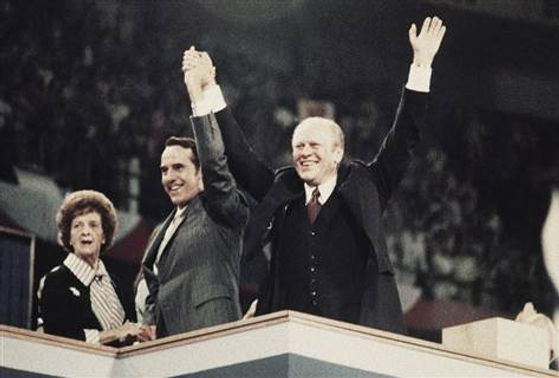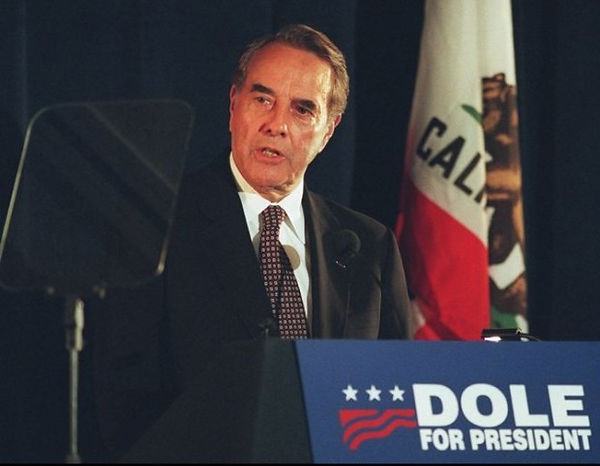

– 2018 Individual Inductee –
Robert Joseph “Bob” Dole
His was the first name mentioned and agreed upon for selection to the First Class of the Russell County Kansas Hall of Fame. The saga of Russell County native son Robert Joseph “Bob” Dole is indeed one for the ages. Rising from a poor childhood and surviving grievous injuries suffered in war, to becoming both a Vice Presidential and a Presidential nominee, Bob Dole over the course of his life has greatly impacted his county, his state, his nation, and indeed the entire world. And at the age of 95 his amazing story is still being told.
Bob was born July 22, 1923 in Russell, Kansas. He grew up with his parents, Doran and Bina (Talbot) Dole, two sisters and a brother in a small frame house. His father ran a creamery and his mother traveled the county selling Singer sewing machines and vacuum cleaners. During the Depression, the Doles moved into the basement of their home and rented out the rest of the house to oilfield workers.
Bob worked a boy at Dawson’s Drugs as a soda jerk, where he learned the power of having a good joke at hand for just the right customer. Bob also worked as a newspaper boy. He was a star athlete in high school, and after graduation from Russell High School in 1941 Bob enrolled as a premedical student at the University of Kansas. There he played football and basketball, and was a star member of the track team.
Halfway through his sophomore year, Bob enlisted on December 14, 1942, in the Army for service in World War Two. He was called up the following year. Throughout his Army training Bob kept himself in top physical shape, hoping to resume his athletic career as soon as he got out of the Army.
A second lieutenant at the young age of 20, Bob arrived in Naples, Italy just a few days before Christmas 1944. A few months later he was assigned to the front in the Apennine Mountains, taking over a platoon in the 10th Mountain Division. He did not know much about his assignment, only that the division has recently been involved in a number of intense battles along the front lines.
The young officer was met with skepticism by the men of his platoon when he first arrived. Battle-hardened, they resented newly commissioned officers. Bob recognized this and worked diligently to gain their trust and respect, always leading from the front.
On April 14, 1945, Bob’s platoon was ordered to take part in an assault on a heavily-defended mound dubbed Hill 913 near the town of Castel de Aiano. One man stepped on a land mine, then another. Suddenly chaos erupted as artillery, machine gun, and mortar rounds flew in every direction. All around Bob men were falling dead and wounded. Knowing that he needed help if he was to save the rest of his men, Bob frantically looked for his radioman. He soon found him, slumped in a heap on the ground, still clutching his radio. Bob scrambled for him and began dragging the radio and his fellow soldier to a nearby shell hole.
Before making it to safety, Bob felt something smash into his back – perhaps a mortar round or machine gun blast – which sent him to the ground. Though Bob’s shattered body was exposed to enemy fire, his men dragged him to safety, giving him as much morphine as he could stand and keeping him safe. Nine hours later he was evacuated from the battlefield. The medics thought Bob would die. Bob did survive, with a shattered right shoulder, fractured vertebrae in his neck and spine, paralysis from the neck down, metal shrapnel throughout his body and a damaged kidney. Bob was later decorated with two Bronze Stars with Valor for his actions on the battlefield, and twice received the Purple Heart.
Bob returned to the United States to recover from his injuries. He was left with limited mobility in his right arm and numbness in his left arm. Bob married Phyllis Holden, an occupational therapist at a veterans hospital, in 1948 in Battle Creek, Michigan. They had a daughter, Robin. The couple divorced in 1972.
With his war injuries, Bob could not follow his pre-war career path. In 1948 Bob enrolled at the University of Arizona, then transferred to Washburn University in Topeka, Kansas, to study law. In 1950 he was elected to a two-year term in the Kansas House of Representatives. In 1952 Bob earned his law degree from Washburn. That same year he was elected Russell County Attorney, a position he served in for eight years.
In 1960 Bob was elected by Kansas’ 6th Congressional District to the U.S. House of Representatives, where he served for four terms from 1961 to 1969. Bob was then elected to represent Kansas in the United States Senate. He was re-elected senator in 1974, 1980, 1986, and 1992. In the Senate Bob served as chairman of the Republican National Committee in 1971–1973, as the ranking Republican on the Agriculture Committee in 1975–1978, and as the chairman of the Finance Committee in 1981–1985. Bob was the Senate Republican Leader from 1985 until 1996.
Dole is a Freemason and a member of Russell Lodge No. 177, Russell, Kansas. In 1975 Dole was elevated to the 33rd degree of the Scottish Rite. Bob married his second wife, Elizabeth Hanford, on December 6, 1975.
In the 1976 presidential election Bob was the Republican Party nominee for Vice President alongside President Gerald Ford, but lost. Bob ran unsuccessfully for the Republican Party presidential nomination in 1980 and 1988 but secured it in 1996. He resigned from the Senate on June 11, 1996, in order to focus on his Presidential bid. Bob lost the general election and retired from active politics.
Shortly after his last election loss, Bob was asked by Chancellor Robert Hemenway to donate his congressional papers to the University of Kansas. Bob and the university conceived the Robert J. Dole Institute of Politics, both to house his papers and as a non-partisan forum dedicated to public service, training for leadership, and promoting the ideal that politics is an honorable profession. The Institute was dedicated in 2003 before a crowd of 25,000 people.
Upon his retirement Bob became a much sought-after public speaker and later served as National Chairman of the successful effort to build the National World War II Memorial. On January 17, 1997, Bob was presented the Presidential Medal of Freedom by President Bill Clinton for his service in the military and his political career. He was awarded the Congressional Gold Medal in January 2018 for services to the nation.
In 1999 Bob endowed the Honorable Robert J. Dole Scholarship for Students with Disabilities at Washburn University, where he later also established the Robert J. Dole Center for Law and Government Fund. The Dole Foundation for Employment of People with Disabilities was established by Bob and provides grant funds to non-profit organizations conducting innovative or best practices employment programs in people with disabilities. On April 12, 2005, Bob released his autobiography One Soldier's Story: A Memoir, which talks of his World War II experiences and his battle to survive his war injuries.
Bob is a currently member of the advisory council for the Victims of Communism Memorial Foundation and is a special counsel for the Washington, D.C., law office of Alston & Bird LLP.
SOURCES:
www.abilitymagazine.com/dole_interview.html
doleinstitute.org/visit/about/history/#sthash.q3qwr9J9.dpuf
cgi.cnn.com/ALLPOLITICS/1996/candidates/republican/dole/early.life/

19-year old Bob Dole, injured in 1942 In Italy during World War II.

1976 Republican Party Vice-Presidential nominee Bob Dole with President Gerald Ford.

1996 Republican Party Presidential nominee Bob Dole.
